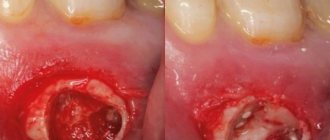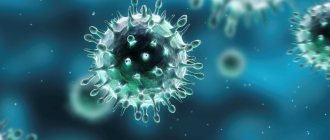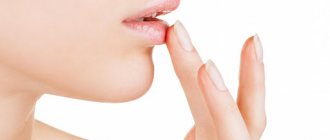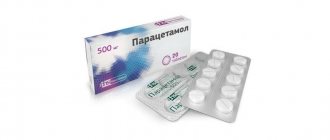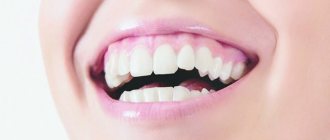The main risk factors for the development of candidiasis include:
- improper oral hygiene;
- wearing orthopedic structures or removable dentures;
- long-term inhalation therapy;
- decreased salivation due to certain pathologies;
- hypothermia;
- stress;
- taking antibiotics;
- changes in hormonal levels;
- decreased immunity, including due to chronic diseases;
- endocrine pathologies, including obesity, diabetes;
- smoking;
- carrying out chemotherapy or radiation therapy.
Oral candidiasis occurs much more often in children than in adults. Newborns can become infected even in utero if the mother has thrush - infection occurs during natural childbirth. After birth, the infection can be transmitted to the child through the skin of the mother's nipples and hands, and from her oral mucosa. The source of infection is unsterile pacifiers and oilcloths, and medical personnel who do not follow the rules of asepsis and antisepsis during invasive procedures. In an older child, oral candidiasis is often caused by a weakened immune system or improper dental care.
ODONTOGENIC AND PERIODONTAL INFECTION
PULPITIS
Main pathogens
Viridans streptococci ( S. milleri
), non-spore-forming anaerobes:
Peptococcus
spp.,
Peptostreptococcus
spp.,
Actinomyces
spp.
Choice of antimicrobials
Antimicrobial therapy is indicated only in case of insufficient effectiveness of dental procedures or spread of infection into surrounding tissues (periodontal, periosteal, etc.).
Drugs of choice
: phenoxymethylpenicillin or penicillin (depending on the severity of the disease).
Alternative drugs
: aminopenicillins (amoxicillin, ampicillin), inhibitor-protected penicillins, cefaclor, clindamycin, erythromycin + metronidazole.
Duration of use
: depending on the severity of the current (at least 5 days).
PERIODONTITIS
Main pathogens
Microflora is rarely detected in the periodontal structure and is usually S.sanguis, S.oralis, Actinomyces
spp.
In periodontitis in adults, gram-negative anaerobes and spirochetes predominate. P.gingivalis, B.forsythus, A.actinomycetemcomitans and T.denticola
are highlighted most often.
In juveniles, there is rapid involvement of bone tissue in the process, with A. actinomycetemcomitans
and
Capnocytophaga
spp.
P.gingivalis
is rarely isolated.
In patients with leukemia and neutropenia after chemotherapy along with A. actinomycetemcomitans
C.micros
is isolated , and in prepubertal age -
Fusobacterium
spp.
Choice of antimicrobials
Drugs of choice
: doxycycline; amoxicillin/clavulanate.
Alternative drugs
: spiramycin + metronidazole, cefuroxime axetil, cefaclor + metronidazole.
Duration of therapy
: 5-7 days.
For patients with leukemia or neutropenia after chemotherapy, cefoperazone/sulbactam + aminoglycosides are used; piperacillin/tazobactam or ticarcillin/clavulanate + aminoglycosides; imipenem, meropenem.
Duration of therapy
: depending on the severity of the course, but not less than 10-14 days.
PERIOSTITIS AND OSTEOMYELITIS OF THE JAWS
Main pathogens
With the development of odontogenic periostitis and osteomyelitis, S. aureus
, as well as
Streptococcus
spp., and, as a rule, anaerobic flora prevails:
P.niger, Peptostreptococcus
spp.,
Bacteroides
spp.
Specific pathogens are less commonly identified: A.israelii, T.pallidum
.
Traumatic osteomyelitis is often caused by the presence of S.aureus
, as well as
Enterobacteriaceae
spp.,
P.aeruginosa
.
Choice of antimicrobials
Drugs of choice
: oxacillin, cefazolin, inhibitor-protected penicillins.
Alternative drugs
: lincosamides, cefuroxime.
When P.aeruginosa
, antipseudomonas drugs (ceftazidime, fluoroquinolones) are used.
Duration of therapy
: at least 4 weeks.
ODONTOGENIC MAXILLARY SINUSITIS
Main pathogens
The causative agents of odontogenic maxillary sinusitis are: non-spore-forming anaerobes - Peptostreptococcus
spp.,
Bacteroides
spp., as well as
H.influenzae, S.pneumoniae
, less often
S.intermedius, M.catarrhalis, S.pyogenes
.
Isolation of S.aureus
from the sinus is characteristic of nosocomial sinusitis.
Choice of antimicrobials
Drugs of choice
: amoxicillin/clavulanate. For nosocomial infection - vancomycin.
Alternative drugs
: cefuroxime axetil, co-trimoxazole, ciprofloxacin, chloramphenicol.
Duration of therapy
: 10 days.
Oral candidiasis is divided into 3 types:
- Pseudomembranous. This is a classic thrush in the form of a superficial white film or white spots. Accompanied by a feeling of slight discomfort. In mild forms of the disease there may be only a few such plaques, and they can be easily removed. In severe cases, many large spots appear, they merge and gradually affect the entire mucous membrane, and can penetrate lower, affecting first the throat, and then the esophagus, up to the gastrointestinal tract. The spots may thicken, making them difficult to remove. Most often, ordinary acute candidiasis occurs in adults who have taken antibiotics, immunosuppressants or corticosteroids, as well as in infants.
- Atrophic. It can be acute or chronic. In the first case, there may be no plaque, but the mucous membrane becomes inflamed - it becomes bright red, the patient complains of a strong burning sensation in the mouth, increased dryness, and sometimes an unpleasant taste with a hint of bitterness or metal. Most often, acute candidiasis is a consequence of drug therapy. The chronic form usually occurs due to wearing orthodontic structures or dentures. The symptoms of the disease are more subtle.
- Hyperplastic. Candidiasis in the mouth affects the lips, corners of the mouth, cheeks, soft palate, and back of the tongue. White spots are usually large, merge with each other, and may acquire a yellow tint. Gradually they become rough and cannot be scraped off. The disease is chronic and is diagnosed only in adults.
Fungal diseases of the pharynx
At the turn of the XIX-XX centuries. Almost all the main human mycoses and their causative agents have already been described. The names of Virchow, Hrubi, Remarque, Schönlein, and then Sabouraud are closely connected with the history of the development of medical mycology. Due to the widespread use of antibiotics, the second half of the 20th century. was accompanied by a significant increase in the incidence of mycoses, which currently affect from 5 to 20% of the adult population (A. Yu. Sergeev, Yu. V. Sergeev, 2003). Among all mycotic lesions of the human body, in second place after onychomycosis is candidiasis of the mucous membranes, up to 40% of cases of which, in turn, are oropharyngeal mycosis (V. Ya. Kunelskaya, 1989).
Among mycoses of the pharynx (pharyngomycosis), the most common (in 93% of cases, according to V. Ya. Kunelskaya (1989), and in 90%, according to T. N. Burkutbaeva (2002)) is candidiasis caused by the yeast fungus Candida, which combines 20 species (A. Yu. Sergeev, Yu. V. Sergeev, 2003). In patients with pharyngomycosis, as a rule, eight different types of pathogens are identified, among which four main ones “lead”: C. albicans, C. tropicalis, C. parapsilosis and C. glabrata. The first place is occupied by the disease caused by C. albicans. This species is found in the mouth and throat of 60% of healthy adults, more often in women and men who smoke. Other Candida species are significantly inferior to C. albicans in the number of discharges from healthy individuals, accounting for 10 to 20% of all cases of oropharyngeal candidiasis. In second place after C. albicans is usually C. glabrata, especially in elderly patients, less often - C. tropicalis, C. parapsilosis (in the latter case - in almost 50% of candidiasis-carrying children). With oropharyngeal candidiasis in HIV-infected people, rare species of Candida—C. sare, C. dubliniensis, C. famata, C. lipolytica and C. guilliermondii—more often appear among the pathogens. It has also been reported that C. rugosa has been isolated from diabetic patients, C. inconspicua and other yeasts from cancer patients. When treated with systemic antimycotics and antibiotics, the proportion of resistant species, C. glabrata and C. krusei, as well as C. kefyr, including those isolated simultaneously with resistant strains of C. albicans, may increase (MD Richardson, DW Warnock, 1997).
Much less often - in 5-6% of cases - mycosis of the pharynx is observed, caused by the bacterial microorganism Leptotrix buccalis and the fungi Aspergillus, Penicillium, Mucor, etc. In some cases, damage to the pharynx is caused by two or more types of fungi - Pharingomycosis mixta.
Almost all of these types of fungi are saprophytes, opportunistic microflora; they are activated and become pathogens when the body’s reactivity is impaired (I. V. Chumicheva, 2003).
The development of pharyngomycosis is provoked by diabetes mellitus, systemic diseases of the blood and gastrointestinal tract, especially intestinal dysbiosis. Deficiency of bifidobacteria and other lactic acid bacteria leads to disruption of the synthesis of B vitamins and to the unhindered colonization of fungi not only in the intestines, but also in other body cavities in contact with the external environment (nasal cavity, mouth, ear). In addition, malignant neoplasms have a negative impact, in which the balance of vitamins, carbohydrate and protein metabolism is disrupted, and the body’s general, including antimycotic, resistance suffers. Mycoses are especially common in AIDS patients, 10% of whom die from fungal infections. Often, pharyngomycosis of the pharynx and oral cavity develops with prolonged and improper use of topical glucocorticosteroids for bronchial asthma.
In the formation of pathogenetic mechanisms of fungal infection of the pharynx, the first place is taken by the restructuring of immune reactivity - the accumulation and circulation of fungal antibodies in the blood, which cause immediate and delayed reactions. Changes in cellular immunity are also important. An important link in the pathogenesis of pharyngomycosis is specific and nonspecific sensitization and allergy. Traumatic damage to the mucous membrane of the pharynx also plays a certain role here - as a factor predisposing to the development of a fungal process.
Mycotic foci in the pharynx are usually localized on the palatine tonsils, arches, velum, posterior wall, and tongue. Tissue reactions are expressed by atypical hyperplasia of the epithelium, the formation of granulomas, sometimes having a pseudotuberculous character, as well as necrotic changes of varying severity. Epithelial hyperplasia in the form of hyperkeratosis is especially pronounced in the crypts of the tonsils against the background of an inflammatory process in the stroma and can take the form of papillomatosis. In the tissues of the mucous membrane of the pharynx, tongue and stroma of the tonsils, fungal elements located subepithelially are detected.
Microscopy of a native preparation is the simplest and most reliable method for diagnosing mycoses, allowing not only to determine the presence of a fungus in the test material, but also to distinguish saprophyty from a fungal disease. With saprophyty, only single non-budding cells are found in the preparations, and with mycosis, all elements of fungi are constantly determined in each preparation: both mycelium and blastospores.
Material is collected from the pharynx for testing for fungi using ear tweezers, Hartmann ear forceps or a Volkmann ear spoon. It is unacceptable to use a cotton swab for this purpose, since the bulk of the sticky pathological content remains on the swab, and therefore a false negative result is possible during microscopic examination or culture. The collected material is carefully applied to a sterile glass slide. The material should not be rubbed on glass, as this may damage the delicate elements of the fungus, which also reduces the reliability of microscopy results. Microscopy of the unstained and Romanovsky-Giemsa-stained native preparation is performed, inoculation of the pathological discharge obtained by scraping from the tonsils or the posterior wall of the pharynx on Sabouraud's selective nutrient medium, followed by subculture of fungal cultures on Chanek's medium to identify the pathogen. When isolating a Candida culture, quantification is often required. In the case of actinomycosis, microscopy reveals a significant proliferation of granulation tissue with actinomycetes.
Immunological diagnosis is based on the detection of pathogen antigens in the blood. Serological diagnostics is a type of immunological diagnostics that makes it possible to detect antibodies to the components of the pathogen cell in the blood. A feature of immunological diagnostic methods is that serial sets of antibodies or antigenic diagnostics are developed only for a few of the most common pathogens (candidiasis, cryptococcosis, aspergillosis; diform fungi). The disadvantages of immunodiagnostic methods include insufficient sensitivity and specificity. However, with the help of immunodiagnostics it is possible, in particular, to monitor the effectiveness of treatment by reducing titers (A. Yu. Sergeev, Yu. V. Sergeev, 2003).
Mycotic lesions of the pharynx can be acute, in which case it is usually accompanied by widespread lesions of the oral mucosa and pharynx, and chronic, in which the lesion is often limited to the palatine tonsils (tonsillomycosis) or the posterior wall of the pharynx (pharyngomycosis); a distinction is made between recurrent and persistent forms of chronic pharyngomycosis. According to the clinical and morphological picture, pharyngomycosis is divided into pseudomembranous, which occurs most often in this localization; erythematous (atrophic), hyperplastic (hypertrophic, or candidal leukoplakia); erosive-ulcerative are rare (A. Yu. Sergeev, Yu. V. Sergeev, 2003).
The clinical picture of pharyngomycosis is varied and is determined not so much by the type of fungus that caused the disease, but by the general and antimycotic activity of the body. The clinical picture of candidiasis, penicilliosis and aspergillosis is almost identical (M. R. Bogomilsky, V. R. Chistyakova, 2001). The disease is characterized by sore throat, fever, hyperemia of the mucous membrane, the appearance of small white plaques at first, and then extensive necrosis of the epithelium, which occurs under the influence of its infection by fungi, which persist when treated with traditional conservative methods. On the mucous membrane, multiple grayish-white plaques of irregular shape are visible, located on the tonsils, arches, palate, as well as in other places and are difficult to remove; after their removal, an eroded surface remains. In the chronic form, typical complaints appear with a characteristic cyclicity, after two to three weeks. With superficial mycosis, a mildly expressed hyperemia of the mucous membrane is determined with small areas of translucent or dense peak-shaped plaques of a grayish or white color, often having a cheesy, lumpy character. The plaque is easily removed, revealing a smooth, hyperemic mucous membrane. In some cases, plaque can merge and become denser. After their removal, the mucous membrane is exposed, bleeding at the slightest damage, which is very reminiscent of damage to the pharynx due to diphtheria. With ulcerative-membranous lesions, the process is usually localized on infiltrated, tuberous tonsils and spreads to adjacent formations. Ulcers with uneven edges are covered with a white coating that can be easily removed. Regional lymph nodes (za- and submandibular) enlarge slightly and are slightly painful (I. V. Chumicheva, 2003).
Often such lesions are found not only in the pharynx, but also in other parts of the respiratory and digestive tracts, which significantly worsens the patient’s condition. Infection of internal organs by fungi is characterized by an exceptionally severe course, similar in symptoms to sepsis (V. Ya. Kunelskaya, 1989).
Pharyngomycosis is often combined with candidal lesions of the corners of the mouth - “jams”, candidal cheilitis, glossitis. The red border of the lips is sharply hyperemic, infiltrated, has transverse striations, and is covered with a thin grayish coating. In the corners of the mouth there are cracks covered with curdled crusts, painful when opening the mouth. The disease lasts 7-12 days and often has an undulating course. Recurrence of the process is noted in 20-22% of cases (I. V. Chumicheva, 2003).
Leptotrichosis of the pharynx is expressed by the formation of spiny, pointed, very dense outgrowths (stalked films in the form of spikes) of gray or yellowish-gray color on the surface of the unchanged mucous membrane of the palatine, lingual, pharyngeal tonsils, lateral ridges and granules of the posterior wall of the pharynx, as well as on the palatine arches. These outgrowths are a consequence of keratinization of the squamous epithelium, come off with difficulty, in parts and contain Leptotrix buccalis cells. The disease is often asymptomatic and long-lasting; sometimes patients complain of a sensation of a foreign body in the throat. There are no inflammatory changes in the mucous membrane and no fever. The course of the disease is persistent (V. Ya. Kunelskaya, 1989).
Actinomycosis is characterized by the formation of dense, lumpy infiltrates of a dark red color (specific infectious granuloma), slowly growing (sometimes the process manifests itself in the form of acute phlegmon), located most often in the area of the mouth and neck, less often in the area of the tongue, tonsils, nose and larynx. Over time, the tumor suppurates and abscesses form. The surrounding tissues of the chin and cheek are involved in the process, then the tumor can open on its own to form a fistula. In the contents you can find yellow-green druses of the fungus. Due to inflammatory swelling of the masticatory muscles, their trismus appears; regional lymphadenopathy is uncharacteristic (M. R. Bogomilsky, V. R. Chistyakova, 2001).
Candidomycosis of the pharynx should be distinguished from diphtheria, fusospirochetosis and damage to the pharynx due to blood diseases (V. Ya. Kunelskaya, 1989).
A comprehensive method of treating tonsillo- and pharyngomycosis includes three fundamental principles.
- General and local use of modern antifungal drugs (previously used antibiotics are canceled).
- Restoration of disturbed intestinal microbiocenosis. In correcting changes in intestinal microbiocenosis, in turn, three factors are important: normalization of chemical processes in the intestine and the fight against opportunistic flora with the help of diet (products with a bactericidal effect), antibacterial agents, intestopan, mexaform;
- taking bacterial preparations containing live cultures (bifidumbacterin, colibacterin, lactobacterin);
- increasing nonspecific defense reactions of the body, promoting the formation of healthy microflora; For this purpose, eubiotics (atsipol, bactisubtil, hilak-forte, linex) are used in complex therapy of candidiasis from three weeks to three months.
In most cases, treatment of pharyngomycosis begins with the prescription of local therapy, and then, if necessary, systemic therapy with azole derivatives is added: fluconazole (Diflucan, Mycosist, Flucostat, Flumicon) 100 mg/day, ketoconazole (Nizoral) 200 mg/day, and also itraconazole 100 mg/day, etc. In this case, systemic drugs are taken for one to three weeks from one to three courses (LL Patton et al., 2001). The antimycotic effect of these drugs is based on disruption of the synthesis of ergosterol (mycostatic) or its binding (mycocidal) to ergosterol, the main component of fungal cell membranes.
Drugs for local etiotropic therapy are divided into antiseptics and antimycotics. The duration of treatment of acute forms with local antimycotics is usually two to three weeks, with antiseptics - somewhat longer. Treatment is carried out until clinical manifestations completely disappear, and then continues for another week (H.-J. Tietz, 2002).
Antiseptics with antifungal effects are usually prescribed in the form of lubricants and rinses. Lubrication is carried out with 1-2% aqueous solutions of brilliant green or methylene blue, applying them to the previously dried surface of the mucosa. These drugs are widespread and available, but they are inferior in effectiveness to antimycotics, resistance to them quickly develops, and their continuous use leads to irritation of the mucous membrane. Lugol's solution diluted two to three times, or a 10-15% solution of borax in glycerin, are more effective. Rinsing with solutions of potassium permanganate (1:5000), 1% boric acid is carried out two to three times a day or after each meal (M. R. Bogomilsky, V. R. Chistyakova, 2001). It is recommended to alternate local antiseptics every week. Modern antiseptics are more effective - 0.12% chlorhexidine bigluconate or 0.1% hexetidine solution, which is also available in the form of an aerosol. For rinsing, you need 10-15 ml of any of these solutions; the procedure is performed for 30-60 seconds after meals, twice a day. The aerosol is sprayed for 1-2 s. Unlike rinses with antifungals, antiseptic solutions should not be swallowed.
Antimycotics - polyene antibiotics (nystatin, levorin, amphotericin, natamycin, etc.) and imidazole derivatives (fluconazole, ketoconazole, clotrimazole) - are prescribed in the form of solutions, aerosols, drops, regular and chewable tablets. It is necessary to explain to the patient that any drug for local treatment should remain in the oral cavity as long as possible. Nystatin tablets should be chewed and the pulp should be kept in the mouth for a long time. When quickly swallowed, they have no effect on the mycotic process in the pharynx, since they are not absorbed through the intestinal wall.
There is a preliminary report of the effectiveness of the topical non-steroidal benzydamine, available as a spray and rinse. It has anti-inflammatory and local anesthetic effects, promotes epithelization. Irrigation with benzydamine is carried out three to six times a day, an hour before or an hour after meals (I.P. Petrova, A.I. Mashchenko, 2002). However, the status of this study does not allow us to make a final conclusion about the effectiveness of the drug.
In case of widespread candidiasis of the pharynx, it is not recommended to carry out surgical interventions on the lymphatic pharyngeal ring, washing the lacunae of the tonsils, UHF and microwave therapy, steam inhalations, compresses on the neck, as well as the use of penicillin and tetracycline antibiotics (M. R. Bogomilsky, V. R. Chistyakova, 2001). In case of leptotrichosis, removal, cryo- or laser destruction of pathological structures is performed only on the palatine tonsils. In the case of actinomycosis, complex treatment is prescribed: antibacterial and antifungal therapy, iodine preparations orally, wide opening, drainage and washing of inflammatory infiltrates with antiseptics, immunotherapy (actinolysate injections). In severe cases, radiotherapy is performed.
The following recommendations have been developed for the prevention of oropharyngeal candidiasis.
The duration of courses of antibiotic therapy should be sufficient to eradicate the bacterial pathogen, but no more. Antibiotics should not be prescribed prophylactically, particularly for respiratory viral infections. When prescribing repeated courses of antibiotic therapy, mandatory concomitant antifungal therapy is indicated.
It is necessary to monitor the condition of the oropharyngeal mucosa during treatment with local and systemic corticosteroids; Nebulizers are used in the treatment of bronchial asthma.
After each meal, you should thoroughly rinse your mouth with boiled water, a 2-3% solution of baking soda, a weak solution of potassium permanganate, and also brush your teeth with pastes containing antimicrobial additives.
It is necessary to promptly treat caries, periodontitis, chronic tonsillitis and other diseases of the oral cavity and pharynx (A. Yu. Sergeev, Yu. V. Sergeev, 2003).
For questions about literature, please contact the editor
I. I. Akulich, Candidate of Medical Sciences A. S. Lopatin, Doctor of Medical Sciences, Professor of the Central Clinical Hospital of the Medical Center for the Administration of the President of the Russian Federation, Moscow
Treatment of candidiasis in the mouth
There are several types of candidiasis of the oral mucosa, but treatment tactics do not differ significantly.
The most commonly used drugs for oral candidiasis are local antimycotics in the form of aerosols, solutions, gels, for example, fenticonazole, miconazole or amphotericin B.
Additionally, antiseptics with antifungal activity are used in the form of solutions for rinsing or lubricating lesions. For rinsing, preparations based on hexetidine and chlorhexidine are often used. A good medicine for candidiasis in the mouth is Lugol's solution, it is used to lubricate plaques.
To strengthen the immune system, it is recommended to take vitamins, especially C, P and group B.
Oral and even infusional antifungal antibiotics for oral candidiasis (sertaconazole, miconazole, isoconazole) are required for severe or chronic disease.
It is important that during the therapy period patients follow a diet that excludes fast carbohydrates (all types of sweets), since they are an excellent breeding ground for candida. Patients should refrain from eating sour and spicy foods.
When treating oral candidiasis in children, it is recommended to carry out “alkalinization” - treating pacifiers, bottles and toys that the baby may put in the mouth with a baking soda solution.
PRINCIPLES OF TREATMENT OF INFECTIONS OF THE ORAL CAVITY AND MAXILLOFACIAL AREA
Treatment of odontogenic infection
often limited to local therapy, including standard dental procedures.
Systemic antibacterial therapy is carried out only when odontogenic infection spreads beyond the periodontal period (under the periosteum, into the bones, soft tissues of the face and neck), in the presence of elevated body temperature, regional lymphadenitis, and intoxication.
When choosing antimicrobial therapy in a hospital setting, in cases of severe purulent infection, it is necessary to take into account the possibility of the presence of resistant strains among anaerobes such as Prevotella
spp.,
F. nucleatum
to penicillin, which determines the prescription of broad-spectrum drugs, amoxicillin/clavulanate in monotherapy or a combination of fluoroquinolone with metronidazole.
Due to increasing levels of resistance by Streptococcus
spp.
to tetracycline and erythromycin, these drugs can only be used as alternatives. Since metronidazole has moderate activity against anaerobic cocci ( Peptostreptococcus
spp.), simultaneous administration of β-lactam antibiotics is necessary to increase effectiveness.
Preventive systemic use of AMPs when performing dental procedures in the oral cavity or periodontium does not guarantee a reduction in the incidence of infectious complications in somatically healthy patients. Convincing data on the sufficient effectiveness of topical antibiotics for oral infections have not been obtained. At the same time, oral bacteria are a reservoir of determinants of resistance to AMPs. Excessive and unjustified use of antibiotics contributes to their appearance and the development of resistance of pathogenic microflora.
Prevention
To prevent the development of the disease, you should carefully monitor the condition of the oral cavity. Every person is recommended to undergo a preventive examination at the dentist once a year and have their teeth treated on time. People who wear dentures should do so more often. Smoking is also one of the causes of thrush, so it is advisable to give up this bad habit.
During the period of antibiotic therapy, it is necessary to take eubiotics to correct the intestinal microflora.
Popular questions about candidiasis
How to determine candidiasis?
The disease has a specific symptom - white plaque in different parts of the oral cavity.
Which doctor treats oral candidiasis?
Dentist-therapist.
How is candidiasis treated?
Doctors usually prescribe the following medications to treat oral thrush: chlorhexidine or hexetidine solution, as well as nystatin, amphotericin B, or miconazole. They are available in different dosage forms (in the form of a gel, solution, aerosol), everyone will choose the one that is convenient for themselves.


